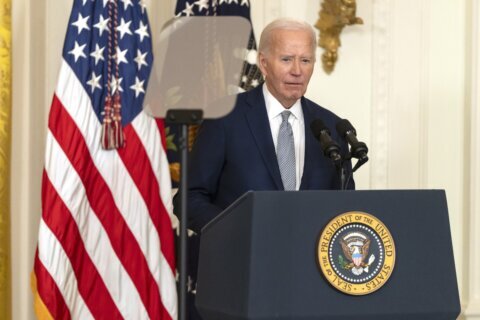For those of you who aren’t fully invested in U.S. equities and believe in the value of international diversification, it’s worth taking a closer look at your portfolio.
Suppose you own the iShares MSCI World ETF (ticker: URTH), which tracks the widely followed MSCI World Index. At first glance, you might think this fund offers comprehensive global equity exposure.
[Sign up for stock news with our Invested newsletter.]
However, there’s a key limitation: The MSCI World Index only includes developed markets.
Currently, nearly 75% of the fund’s holdings are in the U.S., with the remainder spread across developed countries like Japan, the UK, Canada, France, Switzerland, Germany and Australia.
Missing are emerging markets, which represent a significant and growing portion of global gross domestic product (GDP).
“The term ’emerging markets’ refers to countries that are in the middle stage of their development, only recently industrialized, or just opened their markets up to foreign investment,” says Brendan Ahern, chief investment officer at KraneShares. “The largest examples include China, India and Brazil, with some other examples being Turkey, Thailand and Indonesia.”
Maybe you’ve recognized this gap and instead own the Vanguard Total World Stock ETF (VT), a popular global equity fund with $42 billion in assets under management (AUM).
VT tracks the FTSE Global All Cap Index, a more inclusive benchmark than the MSCI World Index, and boasts 9,700 holdings. However, even VT only allocates 9.5% to emerging markets. For every $100 you invest, just $9.50 goes to emerging economies. Why the underweight?
The FTSE Global All Cap Index is market-cap-weighted, meaning it’s based on the total market value of a company’s outstanding shares (calculated as share price multiplied by share count). Emerging-market companies tend to be smaller, which leads to lower representation in such indexes.
This is at odds with economic reality. In terms of 2024 GDP, China ranks second globally, trailing only the U.S. and just ahead of Germany. India sits fifth, just behind Japan but ahead of the UK. France, Brazil, Italy and Canada take the seven through 10 spots, in that order.
“A growing global middle-class population within emerging-market countries could fuel economic expansion at a multiple of general global GDP growth as long as there is enough support,” says Michael Ashley Schulman, partner and chief investment officer at Running Point Capital Advisors.
If you want to truly overweight these up-and-coming economies, you’ll need to supplement your portfolio with a dedicated emerging-market ETF.
Here are seven of the best emerging-market ETFs to buy today:
| ETF | Expense ratio |
| Vanguard FTSE Emerging Markets ETF (VWO) | 0.08% |
| iShares Core MSCI Emerging Markets ETF (IEMG) | 0.09% |
| KraneShares CSI China Internet ETF (KWEB) | 0.70% |
| KraneShares Dynamic Emerging Markets Strategy ETF (KEM) | 0.47% |
| Global X MSCI Argentina ETF (ARGT) | 0.59% |
| iShares MSCI BIC ETF (BKF) | 0.72% |
| Franklin FTSE India ETF (FLIN) | 0.19% |
Vanguard FTSE Emerging Markets ETF (VWO)
“Emerging-market ETFs present an easy, diversified, low-transaction-cost and low-friction path to invest in emerging-market countries using a brokerage account or with the help of a financial advisor,” Schulman says. One of the cheapest and most diversified ETFs in this segment is VWO. For a 0.08% expense ratio, it provides exposure to the FTSE Emerging Markets All Cap China A Inclusion Index.
VWO provides exposure to more than 5,800 market-cap-weighted emerging-market stocks in a single ticker. The ETF is dominated by stocks from China, India and Taiwan. The low 14.4% portfolio turnover rate and the efficient creation/redemption mechanism of ETFs also leads to lower capital gains distributions. This improves tax efficiency for VWO compared to legacy emerging-market mutual funds.
iShares Core MSCI Emerging Markets ETF (IEMG)
“When it comes to selecting emerging-market ETFs, you should consider whether you want broad exposure to multiple developing economies around the globe, a particular region like Eastern Europe, Latin America or Asia, or a focus on a specific country like China, India or Brazil,” Schulman says. For broad exposure, iShares offers IEMG as an alternative to VWO at a 0.09% expense ratio.
This ETF currently tracks the 2,807 stocks represented by the MSCI Emerging Markets Investable Market Index. As with VWO, stocks from China, India and Taiwan dominate its portfolio. However, IEMG also includes South Korean stocks, whereas VWO excludes them. This is because the MSCI indexes classify South Korea as an emerging market, whereas the FTSE indexes classify it as developed.
KraneShares CSI China Internet ETF (KWEB)
“We believe it is also important for investors to understand that not all emerging markets are created equal,” Ahern says. “In particular, China is unique within emerging markets due to its size as the second-largest economy in the world, and its performance characteristics.” For a growth-focused approach to Chinese equities, consider KWEB, which has a technology and internet focus.
This ETF tracks the CSI Overseas China Internet Index. Top holdings include Alibaba Group Holding Ltd. (BABA), Tencent Holdings Ltd. (OTC: TCEHY) and Baidu Inc. (BIDU). KWEB also has an income-focused variant, the KraneShares China Internet & Covered Call Strategy ETF (KLIP). This ETF sells covered call options to transform KWEB’s high volatility into a substantial 58% distribution yield.
[READ: The 10 Biggest Tech Companies in the World]
KraneShares Dynamic Emerging Markets Strategy ETF (KEM)
“As China has differentiated itself from the rest of emerging-market countries from a risk and return standpoint, we believe investors should have a dedicated allocation to the country rather than just lumping it into broad emerging markets,” Ahern says. “Thus, we created KEM to dynamically allocate between China and emerging markets other than China based on fundamental and technical signals.”
KEM actively manages its exposure between the KraneShares MSCI All China Index ETF (KALL), the KraneShares MSCI Emerging Markets ex China Index ETF (KEMX), and up to 10% in cash based on fundamental and technical signals. Typically, the ETF will adjust its allocation on a quarterly basis, but it has the discretion to make intra-quarter changes if needed. KEM charges a 0.47% expense ratio.
Global X MSCI Argentina ETF (ARGT)
One of the standout emerging-market ETF performers in 2024 was ARGT, which soared 63.5% last year. The rally followed the election of libertarian Javier Milei, under whose leadership monthly inflation dropped to 2.7% in November 2024 — the lowest in three years — down from a staggering 25% earlier in December 2023.
“Milei’s initial measures, which include steps towards currency liberalization, labor reforms and privatization of state-owned enterprises, have been widely applauded by the market,” says Malcolm Dorson, senior portfolio manager and head of emerging markets strategy at Global X ETFs. Dorson says long-term tailwinds for Argentina stem from its vast natural resource base and educated population.
iShares MSCI BIC ETF (BKF)
BKF offers investors the closest approximation to investing in the countries of the BRICS coalition — Brazil, Russia, India, China and South Africa — in a single package. BRICS is increasingly seen as a counterbalance to NATO in shaping future geopolitical dynamics. BKF tracks the MSCI BIC Index, which includes 673 stocks from China, India, and Brazil — three of the largest emerging-market countries.
However, Russian equity exposure is hard to come by, as many Russia-focused ETFs were liquidated following sanctions imposed after the invasion of Ukraine. To round out BRICS exposure, you can easily add South Africa to your portfolio with the iShares MSCI South Africa ETF (EZA). However, BKF doesn’t come cheap, with a 0.72% expense ratio. It is also less liquid than many peers, with a 0.18% median bid-ask spread.
Franklin FTSE India ETF (FLIN)
“India is currently Asia’s third-largest economy, and its population growth is projected to soon outpace that of China,” says Dina Ting, senior vice president and head of global index portfolio management at Franklin Templeton. “It poses interesting growth opportunities for investors, as the country is positioned to benefit from favorable demographics, rising incomes and a growing middle class.”
Investors can obtain affordable exposure to Indian equities via FLIN at a 0.19% expense ratio. This ETF currently tracks 245 market-cap-weighted Indian equities represented by the FTSE India Capped Index. Top holdings U.S. investors may recognize include HDFC Bank Ltd. (HDB), Infosys Ltd. (INFY) and Tata Consultancy Services Ltd. (TCS.NS). FLIN is well capitalized, with $1.7 billion in AUM.
More from U.S. News
5 Best Nuclear Energy Stocks and ETFs to Buy Now
5 Best S&P 500 Index Funds to Buy Now
7 Best Cryptocurrency ETFs to Buy
7 Best Emerging-Market ETFs to Buy for 2025 originally appeared on usnews.com
Update 01/02/25: This story was previously published at an earlier date and has been updated with new information.







